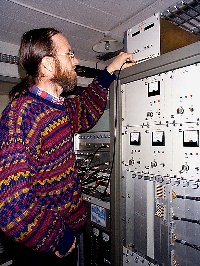DEVELOPMENTS
Telescopes & Receivers
Telescope Control
A major part of the MERLIN Restructuring Grant to enhance the reliability of MERLIN was the replacement of the main axis drives on the three E-Systems telescopes together with their associated servo-control systems. The E-systems servo-control hardware has now been replaced on all three telescopes and the servo loop closed by their on-site computers, so removing a life expired system and thus improving system reliability. The replacement of the drive motors and associated power control systems were implemented for two of the telescopes in the summers of 1999 and 2000. The third is to be replaced during the summer of 2001. A Programmable Logic Controller (PLC) based system, located in the Pedestal Room of the telescopes as part of the monitoring and control of the drive system, has greatly reduced the wiring between the telescope structure and control room, thus ensuring improved system reliability. A working group has been looking at the phased replacement of the telescope control computers with new computer systems suitable for the greater role that they would be called upon to play in the additional control and monitoring of the Optical Fibre Link systems envisaged in e-MERLIN.
Frequency Flexibility
Frequency flexibility, in particular the ability to switch quickly between C-Band (5GHz) and K-Band (22GHz) to take advantage of suitable periods of weather for K-Band observations, has now been achieved, with remotely controlled frequency changing in operational use on all 5 MERLIN telescopes capable of operating at K-Band. To this end, three nonstandard C-Band cryostats have been rebuilt to provide full interchangeability. The opportunity has also been taken to improve their sensitivity. A new focus box has been designed and built for the Defford Telescope. This will allow almost instantaneous switching between L-Band (1.3 to 1.7 GHz) and C-Band receivers. As the new box (and contents) will be substantially heavier than the existing (single frequency) box it has been necessary to assess its effect on the structure of the telescope, design and build new hoisting arrangements and obtain new certification for the entire focus box handling system.
L-Band Lens
At present, the L-Band feeds on the E-Systems telescopes are mounted at the prime focus. To allow full frequency flexibility they will need to be mounted on the carousel at the secondary focus. However, it is not possible to mount a sufficiently large feed to illuminate the secondary reflector efficiently so a lens will have to be incorporated into the feed system. The lens will be mounted on a swing arm at the side of the carousel and swung into position when the L-Band observations are made. Development work on the design of a suitable lens and the associated feed horn is taking place and tests have been made using a small prototype system scaled to K-Band.

